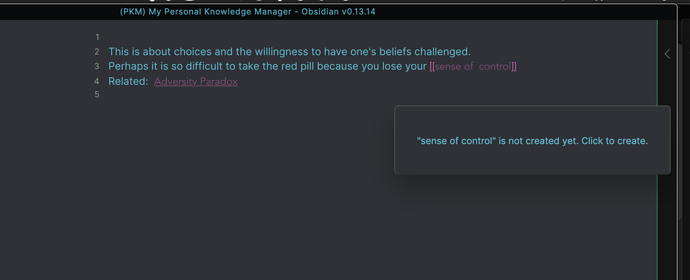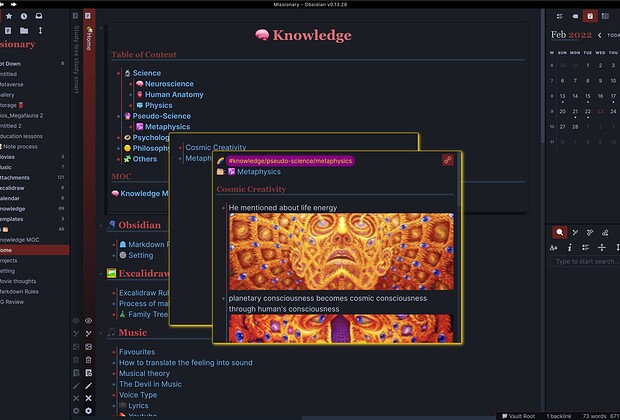just discovered transclusions, feels like I just got a really cool Christmas present
@KaneDodgson: I discovered transclusions in TiddlyWiki. When I left TW, found Obsidian and saw it also supported them, I was over the moon.
AFAIK no other markdown app supports transclusions.
@Klaas It is a really neat feature, finding it really useful to create a virtual one page full of notes and personal reflections. I would be interested to know how you are using this feature, in what situations. I am really over the moon to explore ways of utilising this feature more.
Briefly, I have 2 sets of notes: a zettelkasten -with short, atomic notes - and a Geopolitical collection with (very) long notes.
In the zk, thanks to Obsidian, I have suddenly started links/relationships more clearly. From there I can construct what I call “story rivers” (term borrowed from TiddylWiki, though with a somewhat different meaning).
The story rivers tell a story based on a combination of various notes. A story river is nothing more than a series of transclusions interlaced with some comments, views, conclusions.
With my Geopolitical notes I am starting to do the same, and transclusions also allow me to shorten the notes (apart from excising parts) by not having to repeat a section of text, using a transclusion instead.
1 additional transclusion functionality I would love to have is more to be able to go 2-3 levels deep of transclusions. There is a feature request in for it, but I am not so sure it’ll get implemented.
Yes that resonates with me I have a set on notes that act as a bridge from my seed notes to my permanent notes and articles. Now using your story river reference these can become almost draft pages between the two a place to begin piecing together stories
Glad someone mentioned that! Together with all the other arguments this is the most important reason one should use text (or markdown) to write notes.
Another Brain user here. Version 11 of The Brain completely rebuilt the note editor from scratch (vs. using a third party component). It now is fully Markdown. I am trying to work out some combination of The Brain - nvAlt - Obsidian. I import the Markdown notes into The Brain as file references, but they are editable in The Brain. If you start a note in The Brain, it creates a markdown file that is somewhat hidden. So I have to think more about whether integration works.
Doing it on one computer seems like it might work, but iPad would just be a Markdown editor like Byword or Drafts.
What is the advantage of a combination of The Brain-nvAlt-Obsidian ? Seems like all 3 fulfill basically the same niche?
That’s what I am aiming to find out! Three sounds like too many.
- The Brain has been a collection point of a lot of web URL’s and then linked together. Ingested PDFs and MD files are searched
- nvAlt is pure speed. Search and start typing. This is my day to day drop notes in from meetings and conversations (somewhat akin to Daily notes plus mini-CRM plus project notes)
- Obsidian i am just exploring, but i think for more Evergreen longer thought process
My five cents:
Unless you don’t have more than 20K daily working notes I shouldn’t worry a lot about speed. I am currently doing some volume tests to see where that limit would be for Obsidian. I can safely put that 1000 notefiles (.md) work very well without any issue even graphing included. So for a daily notekeeping flow seems Obsidian will be able to do the job exactly fine (on a desktop).
I you making your raw notes during the day you can use whatever program you’d like and save the files to the shared cloud location.
In the evening you than take your laptop and process everything in Obsidian.
You can even separate the Notetaking space and rest of the vault if you’d like to when you don’t want your coleagues to see what a beauty of information you have gathered in your vault 
@KaneDodgson: 0.8.15 has just been released to the insider channel, and guess what: embedded files (i.e. transclusions) can now go 5 levels deep!!! yay !
Realy! Oh that sounds so much fun my Obsidian space is already littered with them and now looks really visual like mini books inside each page ( I got carried away adding photos to pages so now Obsidian looks like a giant blog feed).
I defo need to pay up some cash and move up a level or two thank you @Klaas
what you mean by connection at the block level?
@RikD ~ When you talk about having not more than 20K working notes, does this imply that, over time, the working notes are gradually transferred OUT of Obsidian into other applications and/or into other Obsidian vaults?
The reason I ask is that I’m keenly interested in giving Obsidian a test run. However, as a long-term user of TheBrain with one large private megabrain (i.e., over 46,000 thoughts/nodes), I’m also concerned about some of the discussions I’ve seen about challenges associated with scalability, processing speed and maximum limits in Obsidian.
If you have any thoughts or feedback to share in this regard, I will be very interested.
Thanks in advance.
P.S.
Thoughts from other long term users of TheBrain and Obsidian welcome, as well!
P.P.S.
I hasten to add: I do not have any ambitious plans to try to import my megabrain into Obsidian. Instead, I would just like to be aware of any size/performance constraints that would impact my use of Obsidian.
Ya, I’ve been thinking about this kind of many-to-many relational diagramming for a while, in part due to process documentation responsibilities at work. Being able to not just link two things, but also describe that link itself, can be very helpful for better documenting things all around – and understanding, and sharing that understanding.
This may have been mentioned before, but in case it hasn’t…
So is Obsidian justa Wiki?
There is a difference between a tool and a methodology.
A wiki is a tool enabling you to write and connect notes via `[[Wiki links]].
Obsidian is a tool enabling you to write and connect notes via `[[Wiki links]].
So looking at them as tools, yes. Obsidian can be used to build and manage a personal wiki, pretty easily.
However…
What you do with those notes is what changes things.
Methodologies such as Zettelkasten, LYT, and many others can be used with a variety of tools. Then it becomes a matter of how well the tool supports the methodology.
Obsidian arguably better supports these methodologies than a simple personal wiki tool. But you can implement these note taking frameworks within something like TiddlyWiki if you wanted to.
Just remember to separate the two and think of them as independent but complementary things.
Decide what methodology you want to use, then select the tool that best supports it.
If you are undecided on a methodology then you should select a tool that supports many methodologies quite well.
That describes Obsidian.
And that the very least being able to name the link is the most basic description i can think of that allows to make sense as to why the connection exists and what it means. Without semantic the tool is like a website, links in all direction that look nice on a graph but can easily become a maze of noise, hard to navigate and hard to search (content search will always yield long lists of maching notes).
If links are the selling point of the software, the first class citizen experience, they need to be rich, useful, searchable, exploited to the full extend possible… That’s what the current internet misses and why it tries to add attributes that can express how a link relates to the resource being pointed.
As pointed above the ability to consider block level granularity (in a way that can’t break) and link block to block, note to block or block to note, or even tasks to block (supported in some competitors) could add a lot in my opinion.
Do not underestimate the power of Preview Pane in Page Preview (Core Plugin). And the theme ITS is the best I came across so far.
- You can open multiple Preview Windows, even open Youtube video (copy and paste embed code) to quickly preview
So, so, so much this. Thanks for posting it; I want to print it out and keep it on my wall. I am moving to Obsidian from Evernote because it’s more stable, more reliable, uses storage I control, has cool features like easy inter-note links and transclusion, and is highly flexible. Markdown is not on the list of reasons. Give me rich text and a rich text editor. If you want to save the file in Markdown, or enhanced markdown, or some other human-comprehensible, open format, great! I do like the notion that if Obsidian dies, or if I want to move to another system, all of my data will just transfer.
Except, I mean, of course, it won’t. The text will be there, but the formatting? Will every other reader parse callouts successfully? How about Dataview? Or the various other plugins I use to get my notes to look like I want, and to replicate the functionality of Evernote?
And it is far from easier to write in Markdown than in a genuine WYSIWYG editor. I’m constantly having to look up how to do things, or downloading a plugin, in order to get my notes to look and act how I want. And in many cases, it’s to get Obsidian to do things that are just standard in any word processor. And don’t tell me that Live Preview is just as good as an actual WYSIWYG editor. It helps, certainly, but it’s just not in the same class.
I can already hear the responses: “Maybe Obsidian’s not for you then?” Well, maybe it’s not. But then, what is? What other app allows such easy linking of thoughts and ideas (down to the paragraph level!), uses a non-proprietary data format (like, I dunno, RTF?), and allows automatic syncing between all my devices using any means I like?
There’s no such thing. MacJournal does some of this, and if it had a decent iOS app, I might still be using it. I gave up on Evernote when it started eating my data. An actual word processor just leaves a lot of unrelated and difficult-to-organize files laying around.
I want to be clear that I’m not bitching. I’m not saying, “Obsidian should abandon (or at least hide) Markdown!” I mean, would I like that? Sure, but Obsidian is working for me, and I’m slowly building up the practices, plugins, and Shortcuts to make it work as I’d like. But it’s a long, slow process, and I’m spending more time learning about Obsidian than I am writing.
I’m just sick of hearing “Markdown is better than a word processor! It lets you focus on your writing, and not on formatting!” Because that’s not how it works for me. If the formatting looks wrong, that’s distracting. And I have to stop writing and go figure out how to make it look and work how I’d like.

